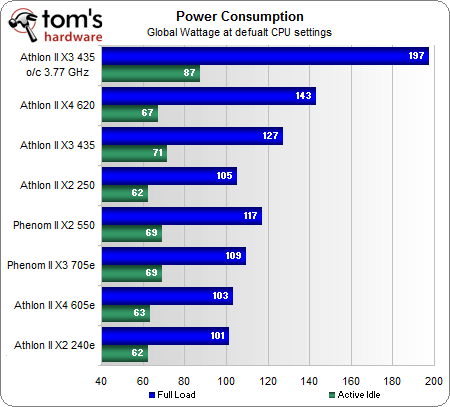Athlon II X3 435: AMD's Three-Core, 2.9 GHz, $87 Triple-Threat
Today AMD introduces what might turn out to be the ideal budget CPU, with three cores for multi-threading, a relatively high 2.9 GHz clock speed, and an impressive sub-$90 price tag. How does it stand up to the rest of the company's Athlon and Phenom IIs?
Power Consumption Benchmarks
To test power usage, we removed the power-hungry Radeon HD 4890 and ran the system using the integrated 785G graphics processor.
We did experience an interesting phenomenon: the system would crash when the C1E power saving feature was enabled in the BIOS (this is something we believed was being enabled in hardware now on AMD CPUs), so we had to leave that option disabled. We contacted Asus about this issue to see if it is a problem with our test sample or if it can be repaired with a BIOS update. Regardless, power usage remained very low.
We did notice that when we enabled the memory power down feature of the motherboard, we saved about six watts both under load and at idle. We were a little surprised at the consistency and quantity of savings with this feature. All of the power consumption benchmarks were taken with the Cool'n'Quiet and memory power down features enabled.
Note that we start the chart at 40W. We generally try to start our charts at zero, but in this case the rest of the system is probably drawing about 40W aside from the CPU. Our goal is to isolate the CPU usage.
Our first thought is that the Athlon II X2 250 is surprisingly frugal for a 3.0 GHz part, coming within a couple watts of its low-power derivative, the 240e. All of the cache on the Phenom II models seem to up the ante, and more CPU cores also require more power.
The new Athlon II X3 435 requires less juice than its quad-core Athlon II X4 620 cousin, but it also delivers better performance in apps and games that depend on clock speed as well as multi-threading, making it a well-rounded CPU.
Overclocking is another story entirely, with load power of the overclocked Athlon II X3 435 consuming more than its brethren. Idling is where most PCs spend their time however, and in this respect the overclocked Athlon II X3 435 draws only 16 more watts than its stock clock speed.
Get Tom's Hardware's best news and in-depth reviews, straight to your inbox.
Don Woligroski was a former senior hardware editor for Tom's Hardware. He has covered a wide range of PC hardware topics, including CPUs, GPUs, system building, and emerging technologies.
-
ominous prime AMD is really thriving in the budget sector, I wonder how the i3's will affect the market. I hope AMD can get back to head to head with Intel on the high end though.Reply -
rdawise Smart move by AMD by attacking the budget crowd (especially around the holiday season). I am surprised how well this thing did against the X2 550! Seems like a good candidate for a budget gaming/multipurpose build. Any release dates available (for NewEgg)?Reply -
tacoslave this is awesome but (and its a big one) i kinda wanted to see something that pwns intels core i7 in everything. Kind of like what they are doing in the graphics department but total domination. How long will i wait!!!Reply -
lemonade4 http://media.bestofmicro.com/O/H/227681/original/Athlon%20II%20X3%20CPU-Z%20Stock.jpgReply
2 cores 2 threads? -
JonathanDeane 3 cores at almost 3Ghz for this cheap? Hmmm not a huge AMD fan but this is plenty of CPU for most people. I would snap one up if I was building a system right now.Reply -
DokkRokken That's one impressive little chip! Pair this with a 770 chipset and you'd have the basis for a cheap and cheerful gaming PC!Reply -
cleeve lemonade4http://media.bestofmicro.com/O/H/2 0Stock.jpg2 cores 2 threads?Reply
Aha! Thanks for catching that. After I had done the testing I was playing around with disabling CPU cores in the OS, and I forgot to turn them back on to take the screenshot. Fixed!
